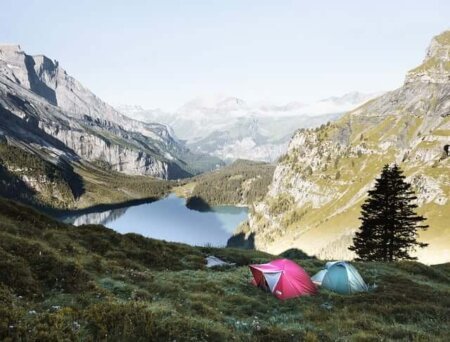Canoeing is a recreational outdoor activity and a sport that involves paddling a canoe through water. A canoe is a narrow and relatively lightweight watercraft, typically pointed at both ends and designed for paddlers to sit or kneel in while propelling it forward using paddles. Canoes are often made from materials like wood, aluminum, fiberglass, or plastic.
Canoeing can be enjoyed in various types of water bodies, including rivers, lakes, ponds, and even the open sea. It is a versatile activity that can be pursued for leisure, exploration, fitness, or competition. There are several different disciplines and styles of canoeing, including:
Recreational Canoeing: This is the most common form of canoeing, where people paddle canoes for leisure, relaxation, and enjoying the natural surroundings. It can be done solo or with a partner, making it a popular choice for family outings and casual trips.
Whitewater Canoeing: In this adrenaline-pumping variant, paddlers navigate fast-flowing and turbulent rivers with varying degrees of difficulty. Whitewater canoes are designed to handle the challenges of rough water and obstacles like rocks and rapids.
Flatwater Canoeing: This type of canoeing takes place on calm, flat water bodies like lakes and ponds. It is often used for activities such as fishing, wildlife viewing, and recreational paddling.
Canoe Camping: Canoe camping combines canoeing with camping, where paddlers travel to remote locations by canoe and then set up camp along the water’s edge. It’s a popular way to explore wilderness areas and enjoy extended outdoor adventures.
Sprint Canoeing: This is a competitive form of canoeing that takes place on flatwater courses. Athletes compete in races of varying distances, including 200 meters, 500 meters, and 1000 meters, using specialized racing canoes and paddles.
Canoe Polo: Canoe polo is a team sport played in canoes on a rectangular pitch. Teams of five players each compete to score goals by throwing a ball into the opposing team’s net. It combines elements of canoeing, ball handling, and strategy.
Canoeing is not only a recreational pastime but also a way to connect with nature, develop paddling skills, and engage in physical exercise. It can be enjoyed by individuals of all skill levels, from beginners to experienced paddlers, and provides an opportunity to explore the beauty of aquatic environments.
Many people enjoy canoeing for a variety of reasons, and the appeal of this outdoor activity can vary from person to person. Here are some common reasons why some people enjoy canoeing so much:
Connection with Nature: Canoeing often takes place in natural settings like rivers, lakes, and ponds, allowing participants to immerse themselves in the beauty of the outdoors. The tranquility of being on the water and surrounded by nature can be incredibly peaceful and rejuvenating.
Relaxation: Canoeing provides a sense of relaxation and escape from the hustle and bustle of everyday life. The rhythmic motion of paddling, the sound of water, and the gentle movement of the canoe can be soothing and meditative.
Adventure and Exploration: Canoeing offers the opportunity to explore new places and discover hidden gems along waterways. It allows adventurers to access remote areas that may be inaccessible by other means, fostering a sense of discovery and adventure.
Physical Exercise: Paddling a canoe is a physically demanding activity that engages various muscle groups, including the arms, shoulders, back, and core. It provides a low-impact cardiovascular workout and helps improve strength and endurance.
Social Interaction: Canoeing can be a social activity that allows people to bond with friends and family. Paddling together in a canoe encourages teamwork, communication, and cooperation, strengthening relationships.
Skill Development: Learning to paddle and navigate a canoe requires skill and technique. Many people enjoy the challenge of mastering these skills and continually improving their paddling abilities.
Wildlife Observation: Being on the water provides opportunities for wildlife observation. Canoeists may encounter a variety of birds, fish, and other aquatic creatures, adding an element of wildlife appreciation to the experience.
Variety of Canoeing Styles: There are different styles of canoeing, such as recreational, whitewater, and canoe camping, which cater to a range of interests and skill levels. This variety allows people to choose the type of canoeing that best suits their preferences.
Sense of Freedom: Canoeing offers a sense of freedom and self-sufficiency, as paddlers are in control of their own journey and can go at their own pace. This feeling of independence can be liberating and empowering.
Cultural and Historical Significance: Canoeing has a rich cultural and historical significance in many regions of the world. Some people are drawn to canoeing because of its connection to indigenous cultures and historical exploration.
In essence, canoeing provides a unique blend of physical activity, relaxation, and a connection with the natural world, making it a beloved pastime for those who appreciate the great outdoors and the serenity of being on the water.
LEARNING CANOEING
Learning to canoe can be an enjoyable and rewarding experience. Here are some steps and tips to help you get started with canoeing:
Take a Canoeing Course:
Consider enrolling in a canoeing course or finding a certified instructor in your area. Many outdoor and recreational organizations offer canoeing lessons for beginners.
These courses typically cover essential skills, safety measures, equipment usage, and paddling techniques. They provide a structured and safe environment for learning.
Start with Flatwater Canoeing:
If you’re new to canoeing, it’s a good idea to begin with flatwater canoeing on calm lakes or slow-moving rivers. This provides a less challenging environment for learning the basics.
Choose the Right Canoe:
Select a canoe that suits your needs and skill level. Longer canoes tend to track straighter and are good for flatwater paddling, while shorter canoes are more maneuverable and suitable for whitewater or smaller bodies of water.
Make sure the canoe is stable and comfortable for your intended use.
Learn Basic Paddling Techniques:
Familiarize yourself with fundamental paddling techniques, such as the forward stroke, backward stroke, sweep stroke, and draw stroke. These strokes allow you to control the direction and speed of the canoe.
Practice these strokes in calm, shallow water until you feel confident in your abilities.
Understand Safety Precautions:
Safety should be a top priority when learning to canoe. Learn about safety equipment, including personal flotation devices (PFDs), and always wear one when you’re in the canoe.
Understand how to handle common safety situations, such as capsizing or swamping, and practice self-rescue techniques.
Master Balance and Stability:
Balancing in a canoe is crucial to prevent tipping. Practice shifting your weight, both individually and with a partner if you’re paddling with someone else.
Learn to maintain balance while entering and exiting the canoe.
Practice Canoe Handling:
Spend time getting comfortable with your canoe in various conditions. Practice maneuvering, turning, and navigating obstacles.
Gradually challenge yourself with different water conditions and environments.
Learn Navigation Skills:
Understand how to read maps and use basic navigation tools like a compass or GPS if you plan to explore new waterways.
Paddle with Experienced Canoeists:
Paddling with experienced canoeists can be an excellent way to learn. They can provide guidance, tips, and real-world experience to help you improve your skills.
Enjoy Gradual Progression:
Don’t rush the learning process. Start with simple outings and gradually work your way up to more challenging conditions as your skills improve.
Be patient and persistent, as canoeing proficiency comes with practice and experience.
Remember that canoeing can be a safe and enjoyable activity when approached with the right knowledge and preparation. Always respect water safety guidelines, weather conditions, and your own abilities. As you gain experience and confidence, you’ll be able to explore different types of canoeing and more challenging environments.
DANGERS OF CANOEING
Canoeing can be a safe and enjoyable outdoor activity when proper precautions and safety measures are taken. However, like any water-based activity, it does come with some inherent risks and potential dangers. Here are some of the primary dangers associated with canoeing:
Drowning: Drowning is the most significant risk associated with canoeing. Capsizing, falling overboard, or getting trapped in a submerged canoe can lead to drowning if a paddler is not wearing a properly fitted personal flotation device (PFD) or lacks the necessary swimming skills.
Capsizing: Canoes can tip over, especially in rough water or when not balanced properly. Capsizing can be dangerous if you’re not prepared to handle it. Proper training in self-rescue techniques and wearing a PFD can mitigate this risk.
Cold Water: Even in warm weather, the water in lakes and rivers can be quite cold. Cold water immersion can lead to hypothermia, which can be life-threatening. Wearing appropriate clothing and being aware of the signs of hypothermia is essential.
Fast-Flowing Water: Whitewater canoeing presents additional risks due to the fast-moving water, rocks, and rapids. Paddlers can get pinned against obstacles or swept away by strong currents. Proper training and equipment are crucial for safely navigating whitewater.
Hazards in the Water: Submerged rocks, logs, and other obstacles can pose a danger to canoers. Colliding with these obstacles can lead to capsizing or injuries. Careful navigation and knowledge of the waterway are essential.
Weather Conditions: Sudden changes in weather, such as thunderstorms, high winds, or heavy rain, can make canoeing hazardous. Lightning poses a significant danger on the water. Always check the weather forecast before heading out and be prepared to seek shelter if conditions deteriorate.
Fatigue and Overexertion: Paddling for long distances or against strong currents can lead to fatigue, which can impair judgment and coordination. Overexertion may also lead to muscle strains or exhaustion.
Inexperienced Paddlers: Inexperienced or untrained paddlers may lack the skills to handle various water conditions and emergencies. It’s essential to gain experience gradually and seek proper training.
Lack of Safety Equipment: Failing to carry essential safety equipment, such as PFDs, whistles, bailers, and first-aid kits, can increase the risks associated with canoeing. Having the necessary gear and knowing how to use it is critical.
Alcohol and Drugs: The use of alcohol or drugs while canoeing impairs judgment, coordination, and reaction time, increasing the risk of accidents and mishaps on the water.
To minimize these dangers and have a safe canoeing experience:
Always wear a properly fitting PFD.
Learn and practice self-rescue techniques.
Take canoeing courses and gain experience gradually.
Be aware of weather conditions and waterway hazards.
Never paddle alone; use the buddy system.
Let someone know your trip plans and estimated return time.
Respect your own skill level and limitations.
Avoid alcohol and drugs when canoeing.
By following safety guidelines and being prepared, you can significantly reduce the risks associated with canoeing and enjoy this rewarding outdoor activity safely.
BEST PLACES TO GO CANOEING IN THE UNITED STATES
The United States offers a wide range of beautiful and diverse locations for canoeing, catering to various skill levels and preferences. Here are some of the best places to go canoeing in the United States:
Boundary Waters Canoe Area Wilderness (BWCAW), Minnesota: Located in northern Minnesota, the BWCAW is renowned for its pristine lakes, interconnected waterways, and untouched wilderness. It’s a popular destination for multi-day canoe trips, offering opportunities for solitude, wildlife viewing, and camping in the wilderness.
Everglades National Park, Florida: Paddling through the vast, mangrove-lined waterways of the Everglades is a unique experience. You’ll have the chance to encounter a diverse range of wildlife, including alligators, manatees, and a variety of bird species.
Okefenokee Swamp, Georgia/Florida: This massive freshwater swamp on the Georgia-Florida border is a prime destination for canoeing. The swamp’s blackwater streams and cypress forests create a captivating, otherworldly environment for paddlers.
Allagash Wilderness Waterway, Maine: The Allagash Wilderness Waterway in northern Maine offers a pristine and remote canoeing experience. Paddle through serene lakes and rivers surrounded by forests and enjoy opportunities for camping and wildlife watching.
Buffalo National River, Arkansas: The Buffalo River is one of the few remaining undammed rivers in the contiguous United States. It flows through the rugged Ozark Mountains, offering paddlers the chance to explore its clear waters, bluffs, and scenic landscapes.
Adirondack Park, New York: The Adirondack Park in upstate New York is a massive and diverse region with numerous lakes, rivers, and ponds perfect for canoeing. You can explore quiet waterways or challenge yourself with some of the region’s famous Adirondack “ponds.”
Quetico Provincial Park, Ontario (Canada) and the Boundary Waters, Minnesota: These interconnected wilderness areas straddle the U.S.-Canada border and provide a vast network of lakes and waterways for canoeists. The wilderness and pristine waters are ideal for extended canoe trips.
Green River, Utah: Canoeing the Green River offers a unique opportunity to explore the stunning canyons of Utah, including Labyrinth Canyon and Stillwater Canyon. The calm waters of the river make it accessible to paddlers of various skill levels.
Apostle Islands, Lake Superior, Wisconsin: Paddling among the Apostle Islands in Lake Superior allows you to explore sea caves, sandy beaches, and rugged shorelines. The crystal-clear waters of Lake Superior provide a remarkable backdrop for canoeing.
Cumberland Island National Seashore, Georgia: Explore the salt marshes, tidal creeks, and pristine beaches of Cumberland Island while paddling. You may encounter wild horses and a variety of coastal wildlife along the way.
Remember to research and plan your canoeing trips carefully, considering factors such as water conditions, permits, and safety precautions. Many of these locations offer guided tours and rental services for canoe enthusiasts of all skill levels, making it easier to experience the natural beauty and adventure that canoeing has to offer in the United States.
REASONS YOU MAY ENJOY CANOEING
Giving canoeing a try can be a rewarding and enriching experience for several reasons:
Connection with Nature: Canoeing allows you to immerse yourself in the beauty of natural environments. Paddling on serene lakes, rivers, or swamps offers a unique perspective of the outdoors, providing opportunities to observe wildlife, birds, and stunning landscapes up close.
Physical Activity: Canoeing provides an excellent full-body workout. Paddling engages your arms, shoulders, back, and core muscles. It’s a low-impact activity suitable for people of various fitness levels, and it can help improve strength, endurance, and cardiovascular fitness.
Stress Reduction: Being on the water and surrounded by nature can have a calming and meditative effect. The gentle rhythm of paddling and the soothing sound of water can help reduce stress, promote relaxation, and clear your mind.
Adventure and Exploration: Canoeing allows you to explore new places and embark on adventures. Whether you’re paddling through a remote wilderness area, navigating whitewater rapids, or exploring coastal waters, canoeing opens up a world of exploration and discovery.
Social Bonding: Canoeing can be a social activity that you can enjoy with friends, family, or a group. Paddling together encourages teamwork, communication, and cooperation, strengthening relationships and creating lasting memories.
Skill Development: Learning to canoe involves acquiring and honing various skills, from paddling techniques to navigation and safety. Mastering these skills can be intellectually stimulating and provide a sense of accomplishment.
Versatility: Canoeing offers versatility in terms of the type of experience you can have. You can choose from various styles, including calm flatwater paddling, thrilling whitewater adventures, relaxing canoe camping trips, or competitive sprint canoeing.
Independence and Self-Sufficiency: Canoeing promotes a sense of self-sufficiency and independence. You are in control of your journey, and the skills you acquire can be valuable in outdoor and survival situations.
Cultural and Historical Significance: Canoeing has a rich cultural and historical significance in many parts of the world. Exploring waterways using this traditional mode of transport can connect you to indigenous cultures and historical exploration.
Memorable Experiences: Canoeing often leads to memorable and unique experiences. Whether it’s watching a sunset from your canoe, encountering wildlife, or camping along a remote shoreline, these experiences can be both enriching and unforgettable.
Accessibility: Canoeing is accessible to people of various ages and abilities. You don’t need extensive training or expensive equipment to get started, making it an inclusive outdoor activity.
In summary, giving canoeing a try can provide you with a blend of physical activity, outdoor adventure, and a deep connection with nature. It offers an opportunity to escape the stresses of daily life, build valuable skills, and create lasting memories while enjoying the beauty and serenity of waterways.































